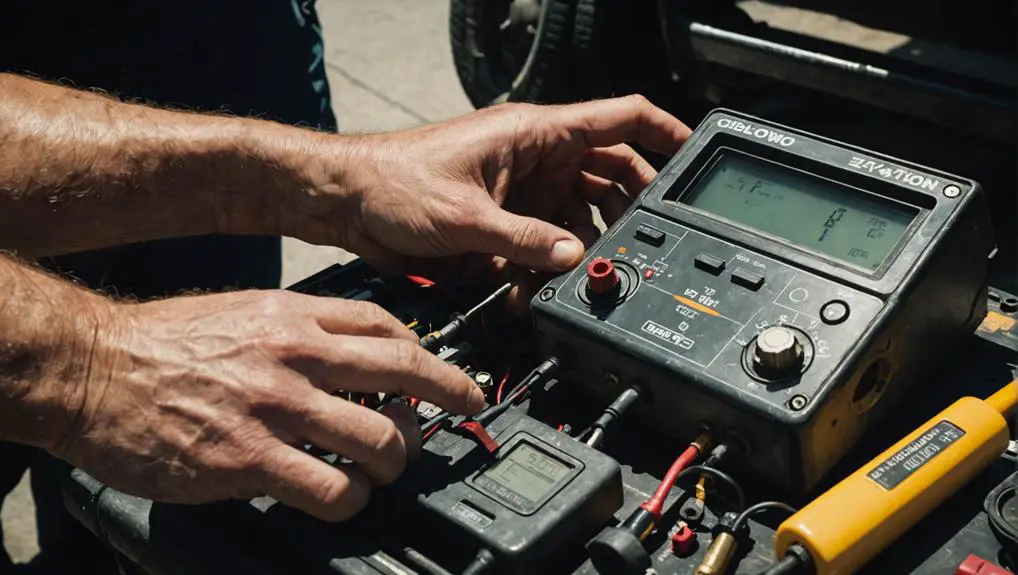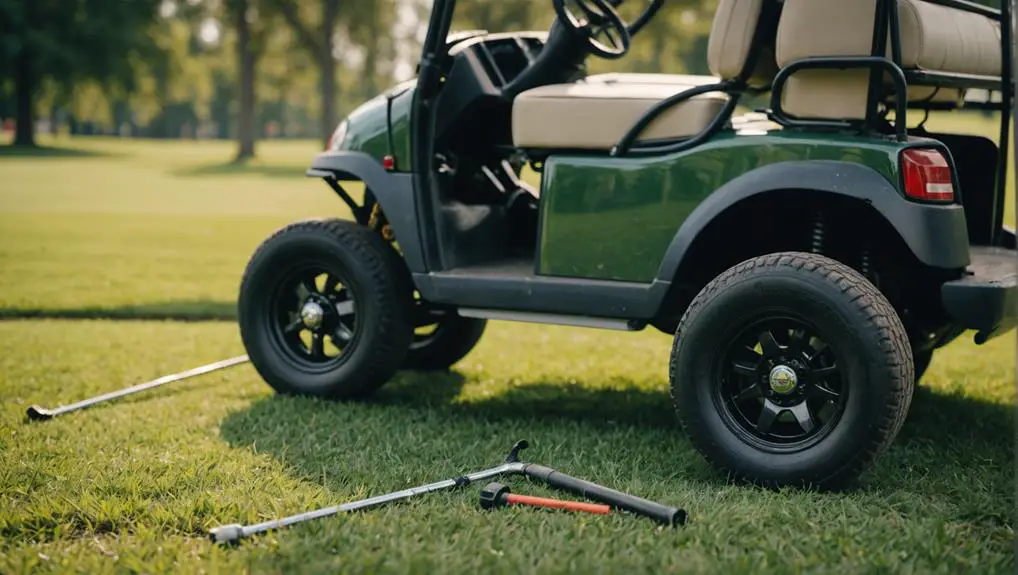When your gas golf cart won't start, it's vital to approach the issue methodically. Start by checking the fuel level to verify you've got enough high-quality gasoline. If that checks out, you'll want to inspect the battery for secure connections and any signs of corrosion. Measuring the battery's voltage is important, too—anything below 12.6 volts could indicate a problem. But there's more to reflect on, and understanding these steps can make all the difference in getting your cart back on the course. What could be the next key component to examine?
Key Takeaways
- Check the fuel gauge and ensure there's adequate fuel; use high-quality gasoline to prevent performance issues.
- Inspect the battery for corrosion, damage, and secure connections; a healthy battery should read 12.6 volts or higher.
- Examine the starter motor for visible damage and listen for a clicking sound when turning the ignition key.
- Inspect the ignition system components, including the ignition switch, coil, and spark plugs, for continuity and proper function.
- Look for fuel blockages by checking fuel lines, filters, and the carburetor for any clogs or debris restricting flow.
Check the Fuel Level
Sometimes, you might overlook the simplest issue when troubleshooting your gas golf cart: the fuel level. Before diving into more complex diagnostics, check your fuel gauge. If it's showing empty or near empty, refuel the cart with the appropriate gasoline. Ascertain you're using high-quality fuel, as contaminated or low-grade gasoline can lead to performance issues.
Next, inspect the fuel lines for any signs of blockage or leaks. Cracks or obstructions can prevent fuel from reaching the engine, causing starting problems. If you spot a leak, replace the affected line immediately to avoid safety hazards.
After refueling, turn the ignition on and listen for the fuel pump. You should hear a faint whirring sound indicating it's functioning. If you don't hear it, there may be an electrical issue or a problem with the pump itself.
Lastly, if you've confirmed adequate fuel and the fuel system is intact yet the cart still won't start, it's time to evaluate other components, but always start with the basics. Confirming the fuel level is sufficient can save you time and effort in troubleshooting.
Inspect the Battery
When troubleshooting your gas golf cart, inspecting the battery is essential.
Start by ensuring the battery is securely mounted and free from corrosion. Look for any signs of damage or swelling, as these can indicate a failing battery. If you notice corrosion around the terminals, clean it off using a mixture of baking soda and water. Make sure you wear gloves and eye protection during this process.
Next, check the battery connections. Tighten any loose terminals, as a poor connection can prevent the cart from starting.
Use a multimeter to measure the voltage; a fully charged battery should read around 12.6 volts or higher. If it's considerably lower, the battery may need recharging or replacement.
If your battery shows signs of wear, consider its age. Most lead-acid batteries last about 3-5 years. If your battery's age is approaching this range or it fails to hold a charge, it might be time for a new one.
Regular maintenance and timely replacement can help prevent starting issues and prolong the life of your golf cart.
Examine the Starter

To guarantee your gas golf cart starts smoothly, you need to examine the starter closely. Start by locating the starter motor, usually found near the engine. Check for any visible signs of damage or corrosion on the connections. If you see rust or dirt, clean the terminals with a wire brush to secure a good electrical connection.
Next, test the starter solenoid. Use a multimeter to check for continuity. If you don't see continuity when the ignition is turned on, the solenoid might be faulty and require replacement. Additionally, listen for a clicking sound when you turn the key; if you hear it, the solenoid is likely engaging.
Inspect the wiring harness connected to the starter. Look for frayed wires or loose connections that could prevent the starter from receiving power. If everything looks intact, you might want to perform a bench test on the starter motor itself.
Remove it from the cart and connect it directly to a power source to see if it spins. If it doesn't work, it's time to replace the starter. Taking these steps will help secure your gas golf cart starts reliably.
Assess the Ignition System
Evaluating your golf cart's ignition system is essential for ensuring reliable starts and smooth operation.
Start by inspecting the ignition switch, as a faulty switch can prevent power from reaching the ignition coil. Use a multimeter to check for continuity when the key is turned. If you find no continuity, it's likely time to replace the switch.
Next, examine the ignition coil. This component transforms low battery voltage into high voltage to create a spark in the spark plug. Look for any signs of damage or corrosion. You can test the coil's resistance with a multimeter; refer to your cart's manual for proper specifications.
Finally, check the spark plug itself. A worn or fouled plug may not ignite the fuel mixture effectively. Remove the plug and inspect its condition. If it's dirty or worn, replace it with a new one.
Here's a quick checklist for evaluating the ignition system:
- Inspect the ignition switch for continuity.
- Test the ignition coil's resistance.
- Examine the spark plug for wear and fouling.
Look for Fuel Blockages

Fuel blockages can significantly hinder your gas golf cart's performance, leading to issues like poor acceleration or stalling.
To diagnose this, start by checking the fuel lines for any kinks or damage. A kinked line can restrict fuel flow, so make sure it's straight and intact.
Next, examine the fuel filter. If it's clogged, it won't allow fuel to pass through efficiently. Replace it if necessary.
You should also inspect the fuel tank for debris or sediment. Contaminants can accumulate at the bottom and obstruct the fuel pickup. If you notice any, clean the tank thoroughly.
Additionally, check the carburetor for blockages. Remove the carburetor bowl and clean it out, as dirt particles can hinder fuel flow.
Frequently Asked Questions
What Tools Do I Need for Troubleshooting a Gas Golf Cart?
To troubleshoot a gas golf cart, you'll need a few essential tools.
Grab a multimeter to check electrical components, a wrench set for tightening or loosening bolts, and a screwdriver for various screws.
A fuel pressure gauge can help diagnose fuel flow issues, while a spark tester guarantees your ignition system's working properly.
Don't forget gloves and safety glasses to protect yourself during the process.
With these, you'll be well-equipped for an effective inspection.
How Often Should I Perform Maintenance on My Golf Cart?
You should perform maintenance on your golf cart at least every 100 hours of use or every six months, whichever comes first.
This includes checking the oil, air filter, and battery levels.
Keep an eye on tire pressure and inspect the brakes.
If you notice any unusual sounds or performance issues, don't wait—address them immediately.
Regular maintenance helps guarantee your cart runs smoothly and prolongs its lifespan, saving you money in the long run.
Can Weather Conditions Affect My Golf Cart's Starting Ability?
Imagine your golf cart like a delicate flower in a storm. Weather conditions, especially cold temperatures and heavy rain, can impact its starting ability.
Cold weather can thicken the engine oil, making it harder to crank. Humidity can cause moisture in the fuel system, leading to starting issues.
To prevent problems, park your cart in a sheltered area and guarantee proper winterization before the cold months arrive. Keeping it dry and warm makes a difference.
What Are Common Signs of a Failing Fuel Pump?
Common signs of a failing fuel pump include difficulty starting your engine, sputtering during acceleration, and a noticeable drop in power.
You might also notice a whining noise coming from the fuel tank or the engine stalling unexpectedly.
If your golf cart hesitates or struggles to maintain speed, it's likely related to fuel delivery issues.
Regularly checking the fuel system can help you catch these problems before they escalate.
Should I Consult a Professional if I Can't Find the Issue?
If you can't pinpoint the issue causing your golf cart's problems, consulting a professional's a smart move.
They've got the experience and tools to diagnose issues accurately.
Don't hesitate to seek help, especially if you're unsure about the mechanical aspects or electrical systems.
It can save you time and potential costs from DIY attempts gone wrong.
Trust their expertise to guarantee your golf cart's back on the course quickly and safely.
Conclusion
Once you've navigated through these troubleshooting steps, your gas golf cart should be ready to hit the greens again. If it still refuses to cooperate, it might be time to seek a bit of professional assistance. Remember, even the most reliable carts can have their off days. By following this guide, you're well-equipped to tackle the common culprits that keep your cart from starting, ensuring your ride is smooth and enjoyable when you need it most.